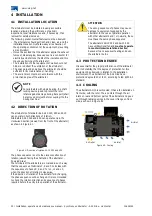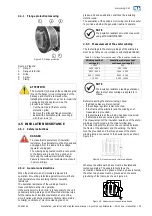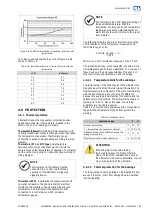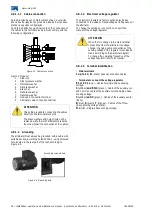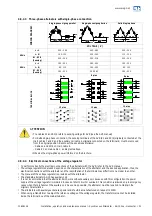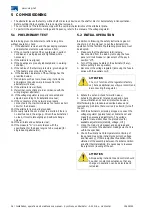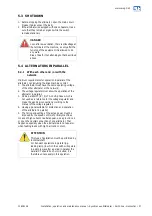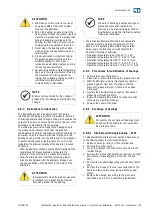
26 l
Installation, operation and maintenance manual – Synchronous Alternator – AG10 line - Horizontal 12638144
4.6.1.3
Temperatures for alarm and shutdown
Temperature of alarm and shutdown must be
parameterized as low as possible. These temperatures
can be determined based on the results of tests or by
operating temperature of the alternator.
The temperature alarm can be set to 10 °C above the
operating temperature of the alternator at full load
considering the highest ambient temperature at the
location. The temperature set to shutdown shall not
exceed the maximum permitted temperatures as listed in
Table 4.6 and Table 4.7.
Table 4.6: Maximum temperature of stator
Class
of Insulation
Maximum temperature of
protection setting (ºC)
Alarm
Shutdown
F
140
155
H
155
180
ATTENTION
Alternators used in emergency systems
(standby) can be elevated up to 25 ºC above
the temperature in continuous operation as
standard NEMA MG 1 and MG-22:40-1-
22.84. Using the alternator in these
conditions reduces the life of the alternator.
Table 4.7: Maximum temperature of the bearings
Maximum temperature of protection setting (ºC)
Alarm
Shutdown
110
120
ATTENTION
The temperature alarm and shutdown can be
set based on experience, but must not exceed
the maximum rate indicated in the Table 4.6
and Table 4.7.
4.6.2
Space heater
When the alternator is equipped with a heater to prevent
condensation of water for long periods without operation,
they must be programmed to be energized after the
shutdown of the alternator and be deenergized before the
switch goes into operation.
The dimensional drawing and an existing specific
identification plate fixed on the alternator indicate the value
of supply voltage and power of the installed space
heaters.
ATTENTION
If the space heaters remain energized while
the machine is in operation, the winding may
be damaged.
4.6.3
Auxiliary winding protection
The alternator has a protection fuse, connected in series
with the auxiliary winding or the voltage regulator, with the
function of protecting it against overload.
ATTENTION
Failure to use the specified fuse may result in
burning of the auxiliary coil and hence of the
stator winding. This defect is not covered
under warranty.
In case of operation of the fuse, it is necessary to replace
it with another of equal value, so that the alternator
operates properly protected.
The fuse protects the alternator and voltage regulator in
the following situations:
1.
Loss of reference (feedback) of the voltage regulator;
2.
4. Connection of the cables of the auxiliary coil in short
circuit, done on output cables of the coil or by
erroneous connection on the voltage regulator;
3.
Connection of the output terminals of the voltage
regulator in short circuit;
4.
Operation at low speed (used to heat the diesel
engine), especially with the function U / F voltage
regulator disabled, depending on the operating
condition (rotate, adjust the regulator and others);
5.
In case of damage to the voltage regulator (burning of
the power element or internal reference failure in the
circuitry for comparison);
The fuse does not operate in case of short circuit of the
alternator phases. In these cases, the protection should
be done with a relay, allowing the motor starting and
protection sensitization.
4.6.4
Protection of the diodes
The diodes are protected against overvoltage and / or
power surge, according to Table4.7.
In case of failure of these components, they must be
replaced.
Table 4.8: Protection of the diodes
Model
Varistor
Capacitor
AG10 250
AG10 280
AG10 315
AG10 355
AG10 400
Type of assembly
THT
THT
Item (WEG)
10049848
10391625
Features
1W, 745Vcc,
550Vca 210J/2ms
0,1µf, 2000Vcc,
630Vca











